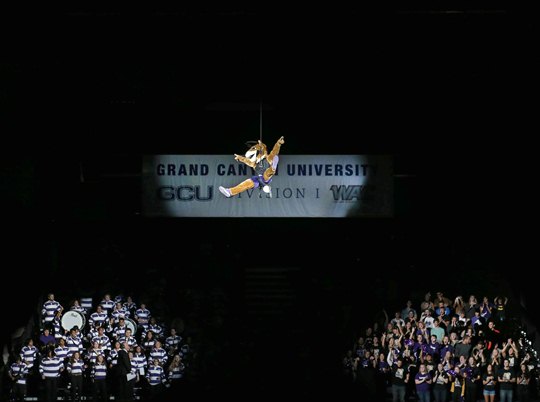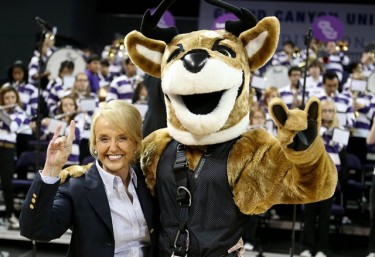By Bob Romantic
GCU Today Magazine
In the game of musical chairs that is NCAA Division I athletics, Grand Canyon University now has a seat at the party and a good idea of where it belongs.
Now all it needs is for the music to stop long enough for the rest of the country to settle down and catch its collective breath.
Since 2011, 70 D-I institutions have switched their conference affiliation (or are in the process of switching) as leagues and universities jockey for position to cash in on revenue streams created by rich television contracts.
GCU, of course, benefited from that instability when it was invited to make the jump to Division I and join the depleted Western Athletic Conference beginning in 2013-14.
“For us, the key was to find our niche that we belonged to, and the WAC seems to be evolving into that niche as a non-football conference,” said Keith Baker, GCU’s director of athletics. “In many respects, the timing has been great for us to come in.”
But given what has transpired
in just the last two years, what
will the rapidly changing landscape look like four years from now, when the Antelopes complete their transition period
to Division I and become eligible for postseason play?
Before looking too far into that crystal ball, it would help to look at how we got here.
A perfect storm
The chaos of the last two years has been a perfect storm that has its roots in a 1984 Supreme Court decision (NCAA v. Board of Regents of University of Oklahoma), which ruled the NCAA violated antitrust laws by controlling the television rights of its member schools.
The resulting deregulation allowed conferences and individual universities to negotiate their own TV deals, and within a year the number of college football games shown on television more than doubled. It also led to the creation of the triumvirate of postseason configurations known first as the Bowl Coalition, then the Bowl Alliance and finally the BCS — all of which were monopolized by larger universities in major conferences that levied their power to cash in on progressively bigger and better television deals.
“The age-old problem in Division I athletics is the rich don’t want to fund the poor and drag them along,” said Dennis Dodd, a columnist for CBSSports.com who covers the NCAA and wrote a series of articles in 2010 examining conference realignment. “Their mindset is ‘We’re the ones who established this tradition and made most of this money.’”
Cashing in on TV rights The five major conferences have signed lucrative TV contracts with ESPN, FOX and/or CBS in the past two years: Conference Avg. annual payout Payout per school Pac 12 (12 teams) $250 million $20.8 million Big Ten (12 teams) $248 million $20.7 million Big 12 (10 teams) $200 million $20 million ACC (14 teams) $240 million $17.1 million SEC (14 teams) $205 million $14.6 million
That mindset, coupled with the growth of cable television and the boom of the Internet, social media and mobile technology, brought everything to a head in the past two years, when each of the five major conferences landed huge TV contracts.
To reap those kinds of rewards, power conferences have had to expand their footprint and add more schools. Being in more homes in more major markets in more states means more money in TV revenue. And since only a handful of athletic programs in the country are actually profitable, that money goes a long way.
So the Pac-12 broadened its base to include Colorado and Utah; the SEC added Texas A&M and Missouri; the Big Ten recruited Nebraska, Maryland and Rutgers; the Big 12 went after West Virginia and TCU; the Big East added Memphis, SMU, Temple, Tulane, Houston and Central Florida; and the ACC brought in Louisville, Pitt and Syracuse. And that’s not counting Boise State and San Diego State, which accepted offers to join the Big East only to reconsider and return to the Mountain West.
Suddenly, 10-team BCS conferences became 12- and 14-member super conferences — and maybe even 16 before all is said and done.
All that movement created a trickle-down effect, as mid-major conferences that had been raided by wealthier BCS conferences in turn started plucking teams from one another or smaller leagues in order to stay relevant.
NCAA President Mark Emmert called the massive conference realignment a “market shakedown” during the Big 12 spring meetings last year.
“What we’ve got is the conflict between the collegiate model and the commercial model,” Emmert told reporters. “Universities need revenue. Everybody thinks everybody is making (a) gazillion dollars in college sports. You know that's not true. … All (of a) sudden, somebody is dangling some resources in front of you. It's tempting.”
WAC expansion, subtraction
Once upon a time, the Western Athletic Conference was the one adding teams and broadening its footprint.
After the collapse of the old Southwest Conference in 1995, the 10-team WAC brought in Rice, San Jose State, SMU, TCU, Tulsa and UNLV, giving it 16 teams stretching from Oklahoma to Hawai’i.
At the time, however, the revenue wasn’t sufficient to split 16 ways and cover travel costs. So by 1999, eight WAC members — Air Force, BYU, Colorado State, New Mexico, San Diego State, UNLV, Utah and Wyoming — left to form the Mountain West Conference.
Over the years, other schools followed suit, with Boise State, Rice, Tulsa, Fresno State, Hawai’i and Nevada among them. After this year, Louisiana Tech, Utah State, San Jose State, Texas State, Texas-San Antonio and Texas-Arlington are departing. And Idaho has announced its intention to leave in 2014.
The exodus has been so great that, just to survive, the WAC next year will become a non-football-playing conference, ending a 50-year history of football that included a national champion (BYU) in 1984, a Heisman Trophy winner (Ty Detmer) in 1990 and two undefeated Boise State (2006, ’09) teams that made national headlines.
Among the nine schools that will comprise the remodeled WAC in 2013-14, including GCU,
none was part of the league prior to 2005. Three members (Texas-Pan American, Chicago State and Missouri-Kansas City) have been added since GCU was invited in November.
“It’s still a very, very fluid situation among conferences,” interim WAC Commissioner Jeff Hurd said of the NCAA shuffling. “One of the primary differences today, compared to two years ago, is it has trickled down to what many people call the non-football-playing conferences. I think we’ll see more movement take place (in the next year) that will affect the landscape and affect conference makeup across the board.”
Hurd hopes to increase WAC membership by one school (two once Idaho leaves) to create a 10-team league. He said it’s important to look five years ahead to maintain stability in a conference.
“From our standpoint, GCU has a number of things attractive about it,” Hurd said. “One is geography. One is ease of access to the city, another is the multisport sponsorship it has, another is the expansion of its campus and its academic programs. It has shown enormous growth potential.
“When you look down the road and look at programs and institutions, those are some of the items you try to target.”
Forecast remains cloudy
As Hurd pointed out, the conference shuffling isn’t complete.
But will it quiet down once the SEC and Big East complete their television contracts and the dominoes finish falling from expansion of the BCS conferences?
Will those conferences look to get even bigger, expanding to 16 teams?
Or is the endgame even more extreme, where those major conferences leave the NCAA and form their own federation, taking all their revenue with them?
Dodd doesn’t like the idea of 16-team conferences — “Anything beyond 14 becomes a little too unwieldy; you’re almost operating as a federation instead of a conference” — but he’s not about to rule out that possibility.
“The divide between the haves and have-nots, no one is sure what form that will take,” Dodd said. “And there’s technology that nobody even thought about that will now be monetized. TV is everywhere, where you can watch games on your phone, a tablet or a computer. ... I think the super conferences and the increase in technology will really revolutionize college sports in the coming years.”
Baker said an endgame in which big schools essentially secede from the NCAA would be devastating to mid-range schools, in essence relegating them to second-tier status.
“It would seem farfetched,” Baker said, “but money makes people do crazy things sometimes.”
Contact Bob Romantic at 639.7611 or [email protected].


















